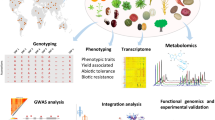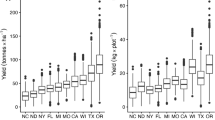Summary
Numerous quantitative genetic studies of yield of maize, conducted at North Carolina State University, are reviewed in order to provide a joint interpretation of the various kinds of evidence found. Estimates of variance components and the comparison of observed and expected response to selection have led to the following conclusions:
-
1.
Sufficient additive genetic variance for yield exists within many locally adapted maize populations to permit improvement by selection.
-
2.
Average dominance for genes affecting yield of ear corn is in the range of partial to complete.
-
3.
Overdominance is not a prevalent source of genetic variation for yield.
-
4.
Linkage disequilibrium can result in effects which mimic overdominance. These effects diminish with random mating.
-
5.
Epistatic variance (i. e., genetic variance not accounted for by additive and dominance variances) is negligible in the varieties, Jarvis and Indian Chief, and in the F 1 hybrid.
-
6.
Short term predictions of response to full-sib and to reciprocal selection, based on genetic theory and computed from reasonably precise estimates of variances, are reasonably reliable.
Zusammenfassung
Die Untersuchung beruht auf 5jährigen Leistungsprüfungen (1958–1962), ausgeführt an zufälligen Stichproben aus kommerziellen Varietäten von Hühnern, die in Iowa auf Legeleistung gezüchtet wurden. In jedem Jahr wurden 15 oder 16 Varietäten von 15–20 Farmen auf Unterschiede in Legeleistung und anderen wirtschaftlich wichtigen Merkmalen untersucht. Die Varietäten wurden in zweifacher Wiederholung sowohl in zufallsverteilten Blocks als auch in Gitteranlagen geprüft. Die Daten wurden in Varianzkomponenten zerlegt, um die relative Bedeutung der Varietäten- und die der Varietäten ×-Farm-Interaktionsvarianz zu bestimmen. Das Verhältnis der Varietäten zur Gesamtvarianz war auf der Basis der Wiederholungsmittel für Eizahl, Stallmortalität, Körpergewicht der Adulten und Eigröße jeweils 0,33, 0,22, 0,26 und 0,42. Der geschätzte genetische Fortschritt in der Legeleistung war bei Verwendung der ertragreichsten unter den 16 getesteten Varietäten 11,5 Eier. Wenn die Selektion der Rasse auf einem Ertragsindex beruht, der mit Hilfe der multiplen Regression des erwarteten Einkommens auf die vier obigen Merkmale bestimmt wird, so ist zu erwarten, daß die geschätzte korrelierte Antwort in einer Steigerung der Eizahl um 11,7, einer Verminderung der Mortalität um 1,8%, einer Abnahme des Körpergewichts um 0,27 kg und einer Zunahme des Eigewichts um 6,5 g je Dutzend besteht. Eine Analyse des optimalen Einsatzes der Prüfverfahren auf maximalen genetischen Fortschritt zeigt, daß unter der Voraussetzung, daß etwa 160 Prüfglieder zur Verfügung stehen, ca. 40–80 Varietäten auf 2 bis 4 Farmen in einfacher Wiederholung getestet werden sollten.
Similar content being viewed by others
Literature Cited
Dickerson, G. E.: Genetic slippage in response to selection for multiple objectives. Cold Spring Harbor Symp. Quant. Biol. 20, 213–224 (1955).
Dickerson, G.: Effectiveness of selection for animal improvement “Germ Plasm Resources”. Am. Assoc. Adv. Sci., Washington, D.C., Publ. No. 66, 161–190 (1961).
Dickerson, G. E.: Implications of genetic-environmental interaction in animal breeding. An. Prod. 4, 47–64 (1962).
Falconer, D. S.: The problem of environment and selection. Am. Nat. 86, 293 (1952).
Federer, W. T.: Evaluation of variance components from a group of experiments with multiple classifications. Iowa Agr. Exp. Sta. Res. Bul. 380, 245–310 (1951).
Fisher, R. A., and F. Yates: Statistical Tables, p. 86–87. New York: Hafner Pub. Co., Inc., 1957.
Goto, E., and A. W. Nordskog: Heterosis in poultry. 4. Estimation of combining ability variance from diallel crosses of inbred lines in the fowl. Poultry Sci. 38, 1381–1388 (1959).
Gowe, R. S., and J. E. Strain: Effect of selection for increased egg production based on past-year records in two strains of White Leghorns. Can. J. of Genet. and Cytol. 5, 99–100 (1963) (Abst.).
Hill, J. F., and A. W. Nordskog: Efficiency of performance testing in poultry. Poultry Sci. 35, 256–265 (1956).
Hill, J. F., and A. W. Nordskog: Heterosis in poultry. 3. Predicting combining ability of performance in the crossbred fowl. Poultry Sci. 37, 1159–1169 (1958).
Logan, V. A.: Combining ability performance of White Leghorn strain crosses. M. S. thesis, Iowa State Univ. Library (1959).
Morris, J. A.: Continuous selection for egg production using short-term records. Austr. J. Agric. Res. 14, 909 to 925 (1963).
Nordskog, A. W.: Importance of egg size and other factors in determining net income in random sample tests. Poultry Sci. 39, 327–338 (1960).
Nordskog, A. W.: Poultry random sample testing in the U.S. — trends and accomplishments. Proc. 13th World's Poultry Congr., pp. 143–147, Kiev (1966).
Nordskog, A. W., M. Festing, and M. W. Verghese: Selection for egg production and correlated responses in the fowl. Genetics 55, 179–191 (1967).
Nordskog, A. W., and O. Kempthorne: Importance of genotype-environment interactions in random sample poultry tests. In: “Biometrical Genetics” p. 159–168. New York: Pergamon Press 1960.
Rajas, B. A., and G. F. Sprague: A comparison of variance components in corn yield trials III. General and specific combining ability and their interaction with locations and years. Agron. J. 44, 462–466 (1952).
Sprague, G. F.: Early testing of inbred lines of corn. J. Am. Soc. Agron. 38, 108–117 (1946).
Sprague, G. F., and W. T. Federer: A comparison of variance components in corn yield trials II. Error, year × variety, location × variety and variety components. Agron. J. 43, 535–541 (1951).
Sprague, G. F., and L. A. Tatum: General and specific combining ability in single crosses of corn. J. Am. Soc. Agron. 34, 923–932 (1942).
Strain, J. H.: Genotype-environmental interactions in caged layers. M. S. thesis, Iowa State Univ. Library (1960.)
Author information
Authors and Affiliations
Additional information
Dedicated to Dr. George F. Sprague on the occasion of his 65th birthday.
Contribution from the Genetics Department, North Carolina Agricultural Experiment Station, Raleigh. Published with the approval of the Director of Research as Paper No. 2325 of the Journal Series. The research was supported in part by Rockefeller Grant 60179, and in part by Public Health Service Research Grant GM 11546. The computing was supported in part by NIH Grant FR-00011.
Rights and permissions
About this article
Cite this article
Moll, R.H., Robinson, H.F. Quantitative genetic investigations of yield of maize. Züchter / Genet. Breed. Res. 37, 192–205 (1967). https://doi.org/10.1007/BF00329529
Issue Date:
DOI: https://doi.org/10.1007/BF00329529




